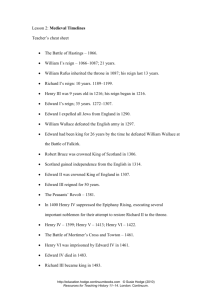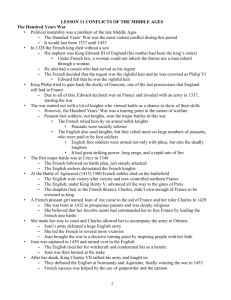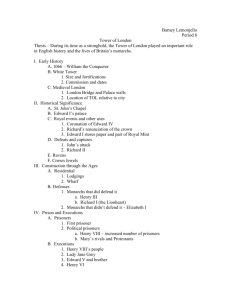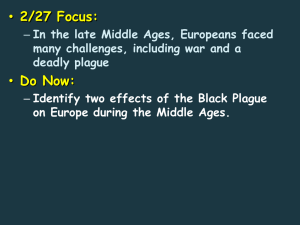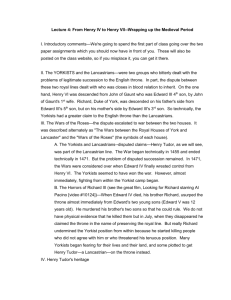The Battle of Towton, the culmination of the
advertisement
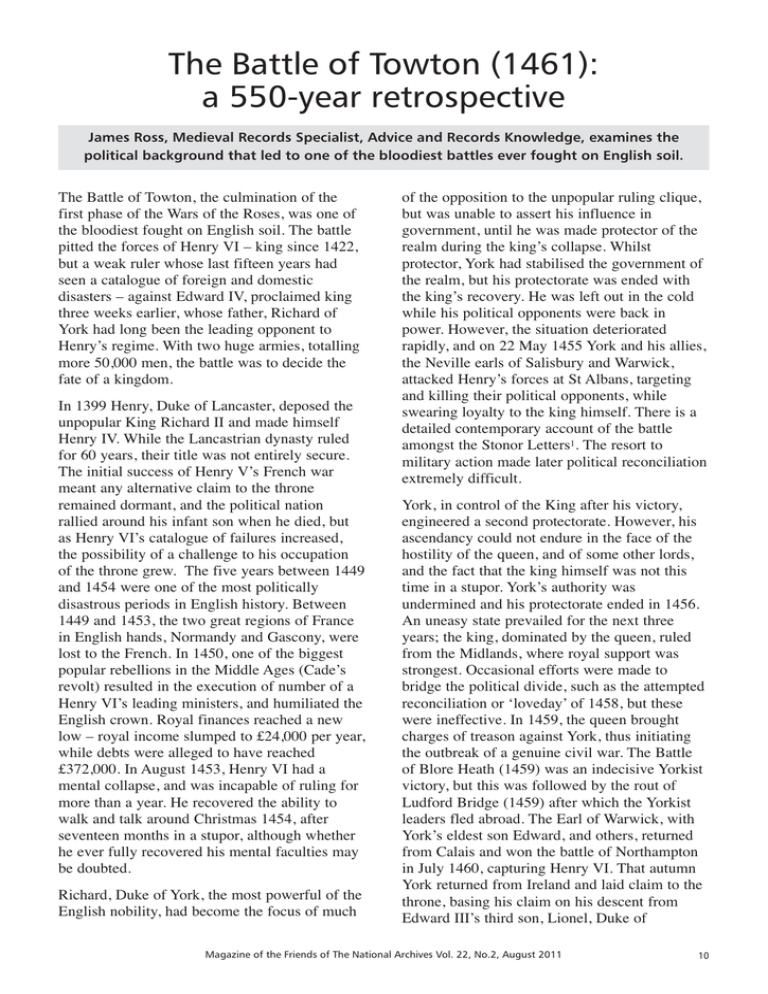
The Battle of Towton (1461): a 550-year retrospective James Ross, Medieval Records Specialist, Advice and Records Knowledge, examines the political background that led to one of the bloodiest battles ever fought on English soil. The Battle of Towton, the culmination of the first phase of the Wars of the Roses, was one of the bloodiest fought on English soil. The battle pitted the forces of Henry VI – king since 1422, but a weak ruler whose last fifteen years had seen a catalogue of foreign and domestic disasters – against Edward IV, proclaimed king three weeks earlier, whose father, Richard of York had long been the leading opponent to Henry’s regime. With two huge armies, totalling more 50,000 men, the battle was to decide the fate of a kingdom. In 1399 Henry, Duke of Lancaster, deposed the unpopular King Richard II and made himself Henry IV. While the Lancastrian dynasty ruled for 60 years, their title was not entirely secure. The initial success of Henry V’s French war meant any alternative claim to the throne remained dormant, and the political nation rallied around his infant son when he died, but as Henry VI’s catalogue of failures increased, the possibility of a challenge to his occupation of the throne grew. The five years between 1449 and 1454 were one of the most politically disastrous periods in English history. Between 1449 and 1453, the two great regions of France in English hands, Normandy and Gascony, were lost to the French. In 1450, one of the biggest popular rebellions in the Middle Ages (Cade’s revolt) resulted in the execution of number of a Henry VI’s leading ministers, and humiliated the English crown. Royal finances reached a new low – royal income slumped to £24,000 per year, while debts were alleged to have reached £372,000. In August 1453, Henry VI had a mental collapse, and was incapable of ruling for more than a year. He recovered the ability to walk and talk around Christmas 1454, after seventeen months in a stupor, although whether he ever fully recovered his mental faculties may be doubted. Richard, Duke of York, the most powerful of the English nobility, had become the focus of much of the opposition to the unpopular ruling clique, but was unable to assert his influence in government, until he was made protector of the realm during the king’s collapse. Whilst protector, York had stabilised the government of the realm, but his protectorate was ended with the king’s recovery. He was left out in the cold while his political opponents were back in power. However, the situation deteriorated rapidly, and on 22 May 1455 York and his allies, the Neville earls of Salisbury and Warwick, attacked Henry’s forces at St Albans, targeting and killing their political opponents, while swearing loyalty to the king himself. There is a detailed contemporary account of the battle amongst the Stonor Letters1. The resort to military action made later political reconciliation extremely difficult. York, in control of the King after his victory, engineered a second protectorate. However, his ascendancy could not endure in the face of the hostility of the queen, and of some other lords, and the fact that the king himself was not this time in a stupor. York’s authority was undermined and his protectorate ended in 1456. An uneasy state prevailed for the next three years; the king, dominated by the queen, ruled from the Midlands, where royal support was strongest. Occasional efforts were made to bridge the political divide, such as the attempted reconciliation or ‘loveday’ of 1458, but these were ineffective. In 1459, the queen brought charges of treason against York, thus initiating the outbreak of a genuine civil war. The Battle of Blore Heath (1459) was an indecisive Yorkist victory, but this was followed by the rout of Ludford Bridge (1459) after which the Yorkist leaders fled abroad. The Earl of Warwick, with York’s eldest son Edward, and others, returned from Calais and won the battle of Northampton in July 1460, capturing Henry VI. That autumn York returned from Ireland and laid claim to the throne, basing his claim on his descent from Edward III’s third son, Lionel, Duke of Magazine of the Friends of The National Archives Vol. 22, No.2, August 2011 10 Clarence. Henry VI was descended from Edward III’s fourth son, John of Gaunt, Duke of Lancaster. York’s claim surprised and dismayed even his closest allies, and in Parliament a compromise was reached by which Henry VI would remain king for life, but Richard of York should be his successor, thereby excluding Henry’s young son, Edward. Clearly unworkable, the compromise lasted only three months. On 30 December 1460, York, his second son Edmund and the Earl of Salisbury challenged a superior Lancastrian force outside Sandal Castle, Wakefield, and were defeated. York’s head was impaled on the gates of the City of York. East Anglia, and popular support in the southeast of England, and was led in person by Edward IV, supported by Richard Neville, Earl of Warwick (‘the kingmaker’). Following a skirmish at Ferrybridge near Pontefract between advance forces of both armies, which cost both sides casualties, the two armies faced each other across agricultural land just outside the small village of Towton, a few miles southwest of York, on a snowy morning on 29 March 1461. What followed was perhaps the most brutal and bloody battle ever fought on English soil. The two sides fought all day (one contemporary account states ten hours), in horrible conditions of sleet and snow. The Lancastrian force, led by Queen Margaret, advanced south, and defeated the Earl of Warwick at the second Battle of St. Albans on 17 February 1461, rescuing Henry VI. However, they were unable to force an entry into London and retreated north. In the meantime, York’s eldest son, Edward, had won a battle at Mortimer’s Cross on 3 February over Welsh Lancastrians, led by Jasper Tudor, Earl of Pembroke. Edward returned to London, and, taking up his father’s claim to the throne, was proclaimed king on 4 March. Playing on fears of the lawless Lancastrian army who, so a royal proclamation stated, had acted in such ‘detestable wise and cruelness as hathe not been heard done amongst the Saracens or Turks to any (Christian) men’,2 Edward ordered all his subjects to resist them. The early part of the battle was dominated by an exchange between the thousands of bowmen on both sides; the wind blowing into the faces of the Lancastrians meant their arrows fell short, but the Yorkist volleys caused heavy casualties amongst their opponents. This forced the Lancastrians to advance, still suffering from Yorkist archery until they could engage. Whilst the archers had dominated the early exchanges, the heavily armoured men-at-arms, knights, esquires and the men of the households of the nobility dominated the hand-to-hand fighting. For much of the afternoon, the two sides hacked at each other in the rain and slush, without quarter. The advantage began to swing to the more numerous Lancastrians, until the arrival of fresh Yorkist troops under the Duke of Norfolk increased the pressure on the Lancastrians, and the tide turned. Raising a large army, Edward advanced north to face the Lancastrians, who had fallen back to Yorkshire, where they had raised an even larger force. Though difficult to estimate, the Lancastrian army was probably about 30,000 men, and was drawn from the crown’s northern estates and the huge military following of the Percy Earls of Northumberland. As neither Henry VI nor Queen Margaret was present at the Battle of Towton itself, the commanders of the army on the day were the leading Lancastrian aristocratic supporters, the Dukes of Somerset and Exeter, and the Earls of Northumberland, Devon and Wiltshire. The Yorkist army was slightly smaller, perhaps between 20,000 and 25,000, and comprised recruits from the Yorkist estates in the southern midlands and the Welsh marches, the retinues of aristocratic supporters in 11 A renewed push by the tired Yorkist troops in conjunction with the new arrivals finally caused the Lancastrians to waver and in the end their line broke. The Yorkists pursued, killing all they could; the topography of the battlefield hindered the Lancastrians’ escape, hemmed in by the stream known as Cock Beck and the long slope, now ‘Bloody meadow’ that led to the River Wharfe. Horrific evidence from the battlefield indicates the merciless slaughter – skeletons have been discovered with multiple wounds.3 A letter from the Lord Chancellor a few days later records that ‘dead bodies were seen to cover an area six miles long by three broad’,4 while legend stated that Cock Beck was spanned by a ‘bridge of bodies’. Several contemporary accounts record the figure of 28,000 dead – Magazine of the Friends of The National Archives Vol. 22, No.2, August 2011 The Royal Clerk's claim for compensation for the loss of cash and a book on the battlefield at Towton, for which he received the sum of £30 approximately 1% of the English population – although this was likely to be considerably exaggerated. One chronicler suggested a more plausible figure of 9,000 Lancastrian dead; even so, the slaughter was undoubtedly greater than any other English battle in the Middle Ages. While the battle was a national event, private stories also emerge. One royal clerk, rather than just counting himself lucky to survive the battle, sought and received compensation of about £30 for losses of cash and a book on the battlefield.5 Three weeks after the battle, on 20 April, Elizabeth Normanvill of Kilnwick, in the East Riding of Yorkshire, made an unusual will.6 In it she was clearly unsure if her eldest two sons, Sir John and William Normanvill, were alive; there are repeated references to each with the clause ‘si vivens sit et non mortuus’ (‘if he be living and not dead’). The likelihood is that both had fought at Towton and on the Lancastrian side and that three weeks later news had not reached their poor mother as to their fate. Whenever the news arrived it was not good, as it is known that Elizabeth’s third son Thomas succeeded to her estates. between Edward IV and Warwick, along with his powerful family, allowed the civil war to resume. In two further victories at Barnet (14 April 1471), where Warwick was killed, and Tewkesbury (4 May 1471), where Lancastrian Prince Edward was killed (Henry VI was put to death shortly afterwards in the Tower of London), Edward exterminated all serious opposition to his rule. He remained king until his early death in 1483. Notes 1. TNA, C 47/37/3 2. TNA, C 54/313, m. 38d 3. www.brad.ac.uk/acad/archsci/depart/resgrp/towton/ 4. Calendar of State Papers: Milan, 1385-1618, p.62 5. TNA, E 404/72/1/26 6. Borthwick Institute, York, Register 2, f. 452 Further Information: A podcast of a talk given by the author at The National Archives on the battle of Towton on 31 March 2011 will shortly be made available for a free download at http://www.nationalarchives.gov.uk/podcasts/ Digital images of six documents illustrating the political background and the battle, with either a transcription or summary of the contents, can be found at Http://www.nationalarchives.gov.uk/documentsonline/ towton.asp Henry VI, Margaret of Anjou and their son Edward were not at Towton, but remained within the safety of York’s walls and were thus able to make good their escape, Edward’s victory was decisive, and forced the political nation to accept him as king. Only a breakdown of the alliance Magazine of the Friends of The National Archives Vol. 22, No.2, August 2011 12

